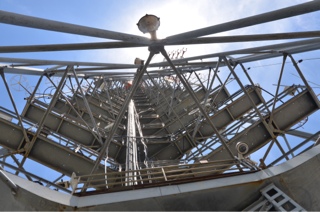Electricity
Pigeons
Illuminated
Candangos
Sadly the capital of Brazil does not have a huge amount to offer tourists. It is a very young city, founded in 1956, conceived by modern standards of urban planning, and so all the attractions (if you can even call them that) are purely architectural.
When seen from above, the city's shape was designed to resemble an airplane. It has received both praise and criticism for its attempt at creating a city by design rather than through "organic" growth. Since the city was completely planned before building it is divided into sectors. There are sectors for hotels, banks, government, commerce and residents.
We first visited Santuário Dom Bosco, which is a church made of 80 concrete columns that support 7500 pieces of illuminated Murano glass symbolizing a starry sky, and which cast a blue glow over the pews. The central chandelier weighs 2.5 tonnes and consists of 435 light bulbs (Imagine the electricity bill for that baby!) Everybody was quite impressed with this building
Cathedral Metropolitana Nossa Senhora Aparecida was surprisingly small from outside. Entrance was gained via an underground tunnel which brought us into a bright and spacious church. Four apostles stood outside the cathedral and angels were suspended from the ceiling inside.
Praça dos Trés Poderes was surrounded by the most interesting monuments, museums and federal buildings. The space consisted of striking sculptures including 'Os Candangos' (8m tall bronze sculpture paying homage to the workers who built Brasilia), 'A Justica' (seated, blindfolded woman with a sword sculpture signifying fairness and the power to achieve it, located in front of the headquarters of the Supreme Court) and 'O Pombal' (a giant wooden clothes peg sculpture that is now home to hundreds of pigeons). The congress building, Congresso Nacional, featured the photogenic ‘dishes’ and twin towers.
Palacio da Alvorada, the presidential palace, was a dull enough building - not very palatial at all. Only interesting thing about it was the fact that the garden was not cordoned off by a wall or fence. It had a tiny, extremely wade friendly, moat with some fishes and that was all. The driveway was guarded and had security gates; but a hop, skip and a jump and you could leap the moat and be running though the garden straight up to the palace. Land-mines were our guesstimate. We later learned that the grounds are supervised by armed guards who have a shoot-to-injure policy for trespassers, and a shoot-to-kill policy for persistent buggers. Nice, n'est pas?
We checked out the memorial for JK (founder of Brasilia Juscelino Kubitschek). Inside lies his remains in a granite tomb. Went for a quick spin over President JK bridge also. Before leaving Brasilia we headed up the 72m high TV Tower which gave 360 degree panoramic views of the city.





































No comments:
Post a Comment